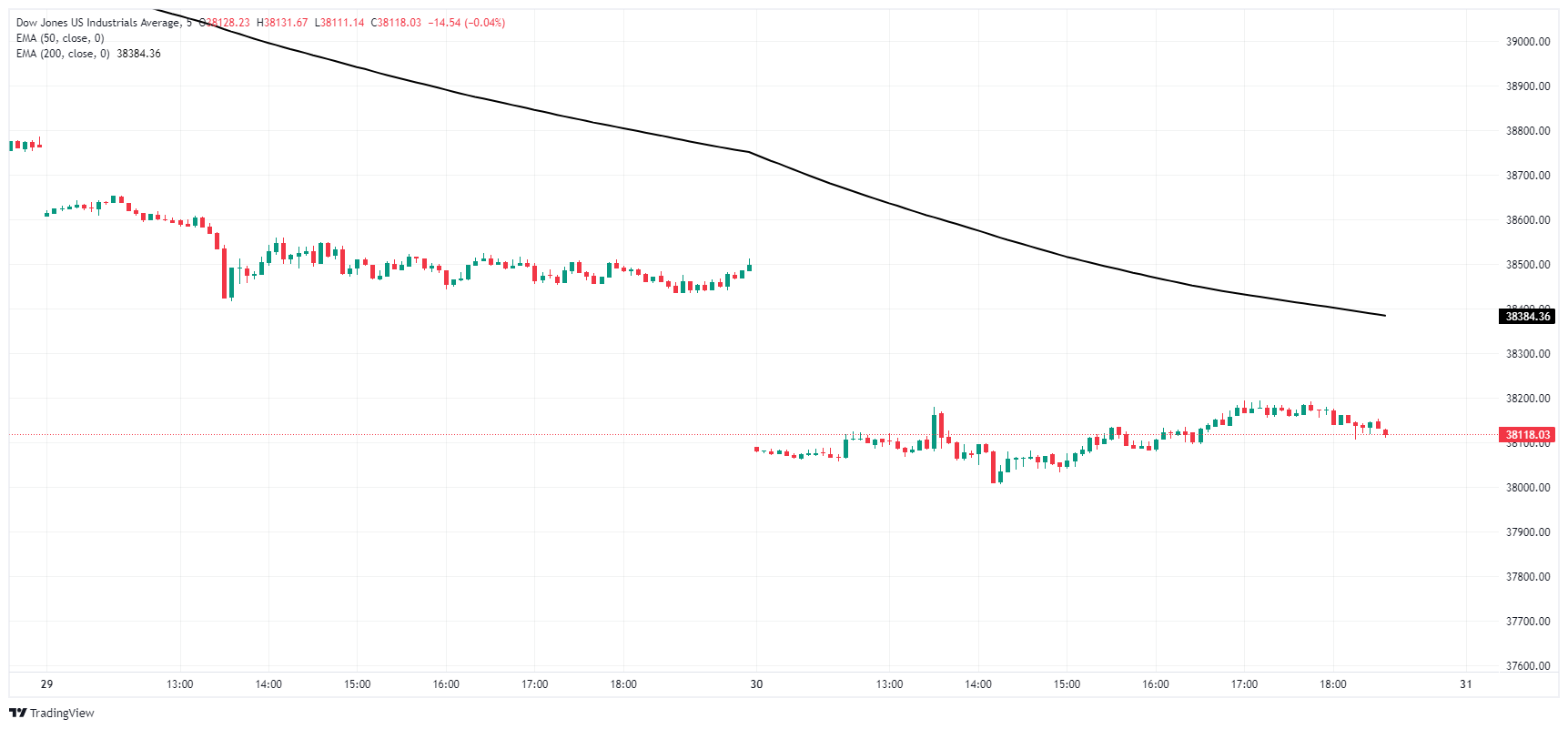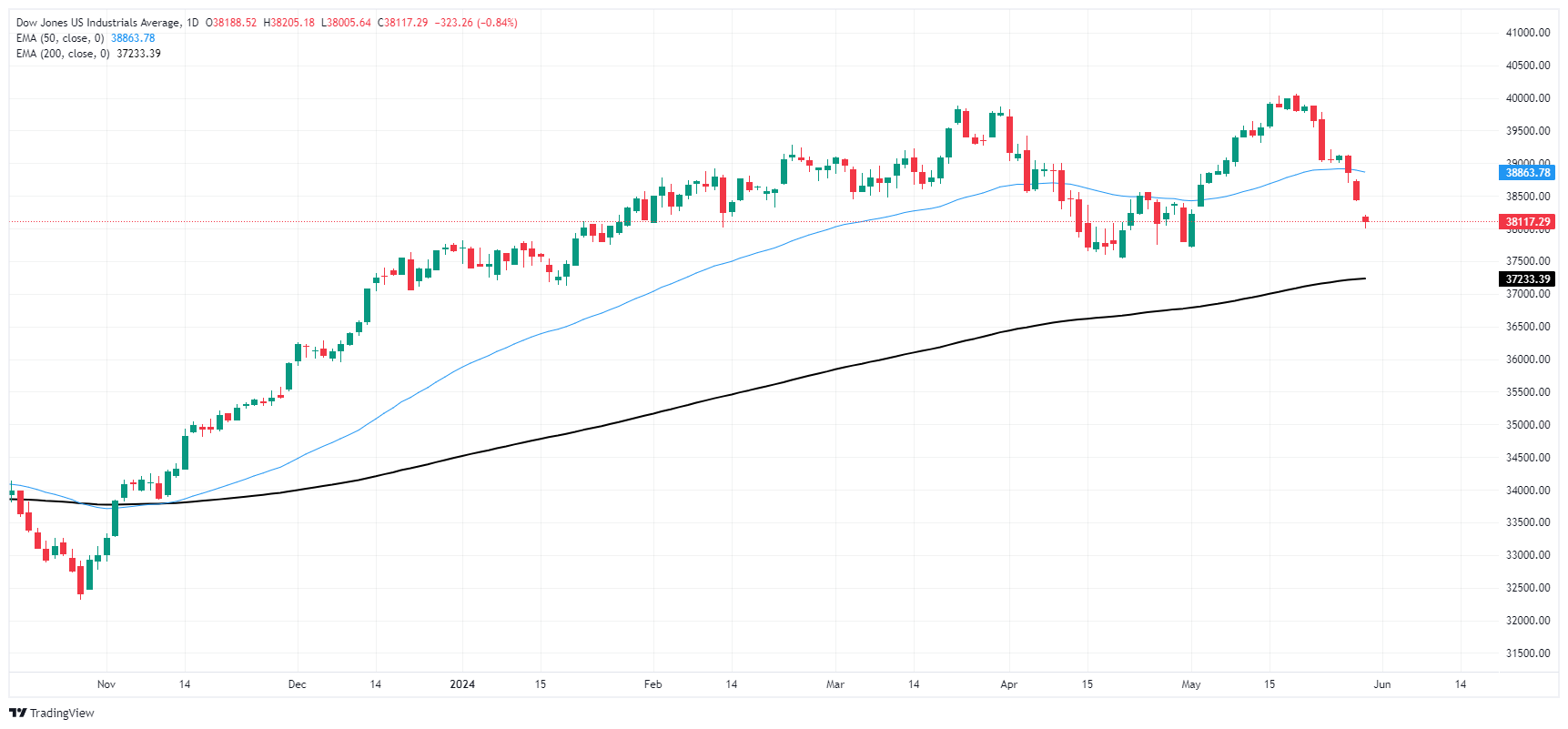- Analiza
- Novosti i instrumenti
- Vesti sa tržišta
- Dow Jones Industrial Average recovers footing on Thursday after US GDP softens, but still remains lower
Dow Jones Industrial Average recovers footing on Thursday after US GDP softens, but still remains lower
- Dow Jones is looking up from the bottom after another gap lower.
- US GDP growth eased as-expected, keeping investors hopeful for rate cuts.
- Steep losses in key equities are keeping indexes sharply lower.
The Dow Jones Industrial Average (DJIA) kicked off Thursday with another bearish gap after overnight trading dragged key securities steeply lower. However, market action in the US session is finding a floor in prices as investors dare to hope for signs of further easing in the US economy.
US Q1 Gross Domestic Product (GDP) grew by 1.3%, in-line with market forecasts and easing from the previous 1.6%. Core Personal Consumption Expenditures (PCE) QoQ also ticked lower to 3.6% when markets expected a hold at 3.7%. With US growth and price inflation showing further signs of cooling off, investors are stepping back into hopes for rate cuts from the Federal Reserve (Fed).
According to the CME’s FedWatch Tool, rate markets are once again pricing in better-than-even odds of at least a 25–basis-point rate trim from the Fed in September. The target rate probability sees only a 49% chance of rates holding at their current level when the Federal Open Market Committee (FOMC) meets in September.
With Thursday figures in the rearview mirror, investors will be pivoting to Friday’s key inflation print, the US PCE Price Index. April’s Core PCE Price Index inflation is expected to hold steady at 0.3% MoM, with YoY Core PCE Price Index inflation also expected to hold at 2.8%. As the Fed’s preferred method of measuring inflation, markets will be watching Friday’s data print closely.
Dow Jones news
Of the 30 constituent securities that make up the Dow Jones, nearly all of them are in the green on Thursday, but steep losses in key equities are keeping the index hobbled.
Salesforce Inc. (CRM), a key cloud-based software company that is a principal player in customer relationship management software, is steeply lower after reported quarterly revenues missed Wall Street expectations. Salesforce reported Q1 earnings of $9.13 billion, slightly lower than analyst estimates of $9.17 billion. CRM also issued lower-than-expected guidance, and this is the first time that CRM has missed expectations since 2006. CRM is down nearly -21.5% on Thursday, falling to $213.62 per share.
Dow Jones technical outlook
The Dow Jones is moderating near 38,100.00 on Thursday, holding steady after a bearish gap down to kick off the day’s trading session. The DJIA is still down from Wednesday’s closing bids near 38,500.00, but priced in an early floor near the 38,000.00 handle.
The Dow Jones is down sharply from record highs set just above 40,000.00 nearly two weeks ago, falling over 5% peak-to-trough. The DJIA is grinding back towards the 200-day Exponential Moving Average (EMA) at 37,233.38, a key technical barrier the Dow Jones hasn’t hit since November of 2023.
Dow Jones five minute chart
Dow Jones daily chart
Dow Jones FAQs
The Dow Jones Industrial Average, one of the oldest stock market indices in the world, is compiled of the 30 most traded stocks in the US. The index is price-weighted rather than weighted by capitalization. It is calculated by summing the prices of the constituent stocks and dividing them by a factor, currently 0.152. The index was founded by Charles Dow, who also founded the Wall Street Journal. In later years it has been criticized for not being broadly representative enough because it only tracks 30 conglomerates, unlike broader indices such as the S&P 500.
Many different factors drive the Dow Jones Industrial Average (DJIA). The aggregate performance of the component companies revealed in quarterly company earnings reports is the main one. US and global macroeconomic data also contributes as it impacts on investor sentiment. The level of interest rates, set by the Federal Reserve (Fed), also influences the DJIA as it affects the cost of credit, on which many corporations are heavily reliant. Therefore, inflation can be a major driver as well as other metrics which impact the Fed decisions.
Dow Theory is a method for identifying the primary trend of the stock market developed by Charles Dow. A key step is to compare the direction of the Dow Jones Industrial Average (DJIA) and the Dow Jones Transportation Average (DJTA) and only follow trends where both are moving in the same direction. Volume is a confirmatory criteria. The theory uses elements of peak and trough analysis. Dow’s theory posits three trend phases: accumulation, when smart money starts buying or selling; public participation, when the wider public joins in; and distribution, when the smart money exits.
There are a number of ways to trade the DJIA. One is to use ETFs which allow investors to trade the DJIA as a single security, rather than having to buy shares in all 30 constituent companies. A leading example is the SPDR Dow Jones Industrial Average ETF (DIA). DJIA futures contracts enable traders to speculate on the future value of the index and Options provide the right, but not the obligation, to buy or sell the index at a predetermined price in the future. Mutual funds enable investors to buy a share of a diversified portfolio of DJIA stocks thus providing exposure to the overall index.
© 2000-2024. Sva prava zaštićena.
Sajt je vlasništvo kompanije Teletrade D.J. LLC 2351 LLC 2022 (Euro House, Richmond Hill Road, Kingstown, VC0100, St. Vincent and the Grenadines).
Svi podaci koji se nalaze na sajtu ne predstavljaju osnovu za donošenje investicionih odluka, već su informativnog karaktera.
The company does not serve or provide services to customers who are residents of the US, Canada, Iran, The Democratic People's Republic of Korea, Yemen and FATF blacklisted countries.
Izvršenje trgovinskih operacija sa finansijskim instrumentima upotrebom marginalne trgovine pruža velike mogućnosti i omogućava investitorima ostvarivanje visokih prihoda. Međutim, takav vid trgovine povezan je sa potencijalno visokim nivoom rizika od gubitka sredstava. Проведение торговых операций на финанcовых рынках c маржинальными финанcовыми инcтрументами открывает широкие возможноcти, и позволяет инвеcторам, готовым пойти на риcк, получать выcокую прибыль, но при этом неcет в cебе потенциально выcокий уровень риcка получения убытков. Iz tog razloga je pre započinjanja trgovine potrebno odlučiti o izboru odgovarajuće investicione strategije, uzimajući u obzir raspoložive resurse.
Upotreba informacija: U slučaju potpunog ili delimičnog preuzimanja i daljeg korišćenja materijala koji se nalazi na sajtu, potrebno je navesti link odgovarajuće stranice na sajtu kompanije TeleTrade-a kao izvora informacija. Upotreba materijala na internetu mora biti praćena hiper linkom do web stranice teletrade.org. Automatski uvoz materijala i informacija sa stranice je zabranjen.
Ako imate bilo kakvih pitanja, obratite nam se pr@teletrade.global.















